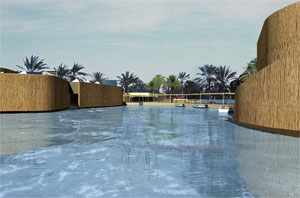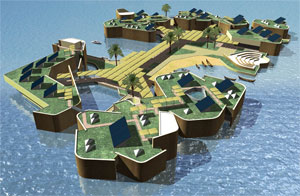| ||
| ||
|
In thinking out the project, Richard Kroeker, professor with the Dalhousie Faculty of Architecture and Planning, spent time in contemplation and construction of the birch bark canoe and the traditional longhouse—a structure made of thin greenwood poles lashed together—trying to understand wood the way the Mi’kmaq did and adapting that knowledge to meet contemporary performance standards. His collaborators on the project include architects Peter Henry and Brian Lilley, also a Dalhousie professor.
The health centre’s timber truss design uses long, slender trees, just six to eight inches in diameter, which are bent into ribs. For awhile, the lawn behind the Ralph M. Medjuck Building served as his incubator, as he and his students experimented and refined ideas. One thing they puzzled out was how to lash the round-wood poles together.
“I think it’s a great lesson for everyone at Dalhousie,” says Prof. Kroeker, who relates that one passerby suggested using metal strapping—a good substitute for the original sinew. “It’s so important to get our research out in the open—a lot of great ideas came from people just walking by… if he didn’t put that bug in our ear, we might have missed it.”
Looking ancient and modern at the same time, the building was completed last summer by people of Pictou Landing. It may have also clinched Prof. Kroeker a prestigious honor by the Erich Schelling Foundation for a body of design work.
This is the kind of award you don’t apply for; an independent design jury awards the medal every two years to recognize “the significant role of the theory of architecture as a creative and socially effective force.” The foundation will award Prof. Kroeker the medal during a ceremony in Germany this month.
“What I’m interested in is the issue of cultural continuity,” says Prof. Kroeker, in his office in the Medjuck Building. Cabinets are lined with models of projects which have been built or are yet to be. “Traditionally, architects have worked for the elites—people with surplus wealth.
“But where design is really needed is in communities which bring issues into sharper focus: where culture is being lost, where there are limited resources and where brain power could make a difference.”
The Pictou Landing Health Centre is just one example of his philosophy put into action. He’s also working on the design of the CDPeace Centre, a school campus with classrooms, residences and an auditorium, in rural Sierra Leone. The centre will serve to train teachers and community workers who are desperately needed in the developing African country after years of civil war. Prof. Kroeker is hoping to use compacted earth, natural plasters and thatch in creating round structures with conical, naturally ventilated rooftops. Construction, using local labour, is expected to begin in November.
“We’re looking at how people traditionally built structures—a knowledge that’s been virtually lost with this war. The skilled trades people just aren’t around anymore,” he says. Before coming to teach at Dalhousie in 1991, he was a practicing architect in London, England. “So we look at the local building science and ask: How can we make it more durable? More cost effective? More durable?”
| ||
|
At one time, the lush marshes of southern Iraq nourished a thriving array of wildlife, flora and fauna. Known as the “Fertile Crescent,” the area was also home to a people known as the Marsh Arabs. But in the 1990s, former Iraqi dictator Saddam Hussein ordered the marshes be drained in retaliation for an uprising against his regime; it was transformed from marshland into a salt-laden desert.
Plans for the research centre—almost a research village—call for laboratories, a library, multi-purpose centre, archaeology and natural history museums, plus food services and living quarters. Prof. Kroeker envisions it be built using compacted earth, canes and reeds—traditional building materials used in the marshlands for centuries.
Prof. Kroeker brings his passion for cultural continuity and social justice to the classroom. He’s also a big proponent of learning by doing. He recently brought a group of grad students to Eskasoni, a Mi’kmaq community in Cape Breton, where they brainstormed solutions to the reserve’s housing shortage.
“These are high-stakes issues. So why not bring in bright young people and let them give some thought as to how they can meet long-term goals?” he says. “These are the best minds of a generation. Rather than keep them closeted in the classroom, let them work on real issues. Let them test out ideas in a context that matters.”
LINK: Erich Schelling Foundation





